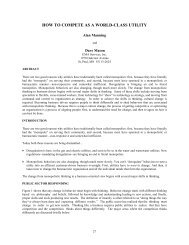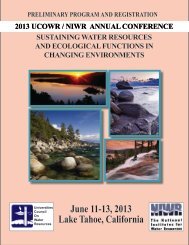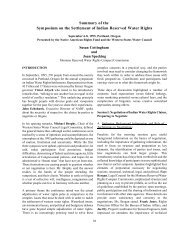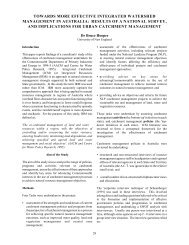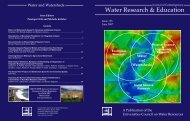66Green <strong>and</strong> Fernández-BilbaoWithin the United Kingdom (UK), thereare increasing differences between practice inEngl<strong>and</strong>, Wales, Scotl<strong>and</strong> <strong>and</strong> Northern Irel<strong>and</strong>,both in terms <strong>of</strong> institutions <strong>and</strong> legislation. Theimplementation <strong>of</strong> the <strong>Water</strong> Framework Directiveis no exception. Hence, this paper will focus onEngl<strong>and</strong>, where 95 percent <strong>of</strong> water bodies are atrisk <strong>of</strong> failing the 2015 objectives. High populationdensities <strong>and</strong> future development are the mainthreats to Engl<strong>and</strong>’s water resources.In contrast with the principles <strong>of</strong> Integrated<strong>Water</strong> Resources Management (IWRM) <strong>and</strong> the<strong>Water</strong> Framework Directive, Engl<strong>and</strong> is a verycentralized country. This is reflected in the choice<strong>of</strong> the Environment Agency as competent authority.The Environment Agency (EA) is the public bodyresponsible for planning <strong>and</strong> managing waterresources (Environment Agency 2004) includingwater quality <strong>and</strong> abstraction licenses. TheEnvironment Agency was established by the 1995Environment Act <strong>and</strong> it is a non-departmental publicbody <strong>of</strong> the Department for the Environment, Food<strong>and</strong> Rural Affairs (Defra) in Engl<strong>and</strong> but it has nodirect democratic oversight.Engl<strong>and</strong>: ContextEngl<strong>and</strong> has a temperate climate where rainfalldoes not vary greatly from month to month.Rainfall is 604 mm/year in the east, compared to1312 mm/year in the west. Although per capitaavailability <strong>of</strong> water in some parts is similar to that<strong>of</strong> Somalia, this is a misleading comparison. <strong>Water</strong>scarcity tends to happen in countries were themajor water user is irrigation (Berbel et al. 2005)<strong>and</strong> only supplementary irrigation is required insome parts <strong>of</strong> Engl<strong>and</strong> (Weatherhead et al. 1994).In European terms, English rivers are small,although there is a variety in length, width, <strong>and</strong>size. Most <strong>of</strong> the rivers are lowl<strong>and</strong>, low-energyexcept in upl<strong>and</strong> areas where there are highenergy rivers that flood quickly. Rivers fulfilla variety <strong>of</strong> functions, including water supply,industry, commerce, irrigation <strong>and</strong> are also usedfor wastewater discharge from sewage treatmentworks <strong>and</strong> other sources. There is some veryminor commercial fishing <strong>and</strong> most fishing is forrecreation. However, the main recreational usesare riverside ones such as walking or enjoyingthe l<strong>and</strong>scape <strong>and</strong> wildlife (Tunstall <strong>and</strong> Green2003). Navigation is mainly recreational althoughthere is a long history <strong>of</strong> commercial navigation(Environment Agency 2001).In terms <strong>of</strong> quality, the first problem faced ismainly diffuse pollution from both agricultural <strong>and</strong>urban areas. Secondly, Engl<strong>and</strong> was the first countryto industrialize <strong>and</strong> rivers were extensively adaptedduring that process, starting with construction<strong>of</strong> weirs <strong>and</strong> races for water mills, <strong>and</strong> going onthrough canalization for navigation, <strong>and</strong> reservoirsto support navigation. Petts <strong>and</strong> Wood (1988) havesuggested that as a result <strong>of</strong> all these activities,around 89 percent <strong>of</strong> United Kingdom’s rivers areregulated or modified to some extent. Rivers arean integral part <strong>of</strong> the potable water supply system<strong>and</strong> <strong>of</strong> the wastewater treatment system: given thesmall size <strong>of</strong> the rivers, it is not uncommon forthe outflow <strong>of</strong> the wastewater treatment worksto constitute 60 percent <strong>of</strong> the base flow <strong>of</strong> theriver. Despite a great improvement in the quality<strong>of</strong> water bodies since the 1990s (EnvironmentAgency 2002) 95 percent <strong>of</strong> rivers are currentlyat risk <strong>of</strong> failing the environmental objectives <strong>of</strong>the <strong>Water</strong> Framework Directive (Department forthe Environment, Food <strong>and</strong> Rural Affairs 2005).Low-flows caused by over-abstraction <strong>of</strong> water isan important issue <strong>and</strong> the Environment Agencyrecently estimated that current abstractions shouldbe reduced by under two per cent in order to avoidenvironmental damage (Environment Agency2004).Engl<strong>and</strong> has, for Europe, quite high domesticwater usage (150 liters per capita per day) <strong>and</strong>it is densely populated (343 people per sq km)accounting for 83 percent <strong>of</strong> the total UnitedKingdom population <strong>of</strong> 49.1 million. Around21 percent <strong>of</strong> l<strong>and</strong> is already in some form <strong>of</strong>urban usage <strong>and</strong> the areas covered by some form<strong>of</strong> environmental designation total 42 percent,including national parks, areas <strong>of</strong> outst<strong>and</strong>ingnatural beauty, sites <strong>of</strong> special interest, <strong>and</strong>green belts. Some areas are covered by multipledesignations, so the proportion is somewhatless. By 2020 there will be around 4 million newhomes <strong>and</strong> much <strong>of</strong> the growth will take place insouth-east Engl<strong>and</strong>, which is also the driest part<strong>of</strong> the country (Environment Agency 2004). Insoutheast Engl<strong>and</strong>, an area roughly equivalent tothe Netherl<strong>and</strong>s in both population <strong>and</strong> size, theUCOWRJOURNAL OF CONTEMPORARY WATER RESEARCH & EDUCATION
Implementing the <strong>Water</strong> Framework Directive67population density exceeds 800 people per sq km<strong>and</strong> some 80 percent <strong>of</strong> non-urban l<strong>and</strong> is coveredby one or more environmental designations. L<strong>and</strong> isa scarce resource in Engl<strong>and</strong> <strong>and</strong> in order to reducenew l<strong>and</strong> take, there is a target <strong>of</strong> 60 percent <strong>of</strong> newhomes to be built on Brownfield l<strong>and</strong> (Office <strong>of</strong>the Deputy Prime Minister 2004) <strong>and</strong> to increaseresidential densities which currently average 27dwellings per hectare.Under pressure from reformers at different times,government in Engl<strong>and</strong> has become progressivelymore centralized. The result was a reduction fromaround 11,000 parish councils, roughly equivalentto 35,000 communes in France, to the current 409district, county or unitary authorities. It is true thatthere are an additional 10,000 or so District orParish Councils, but these have negligible powers<strong>and</strong> funding. In turn, the powers <strong>and</strong> funding <strong>of</strong>local authorities have been progressively reduced.Since Engl<strong>and</strong> has no written constitution, localauthorities have no constitutionally reservedpowers or sources <strong>of</strong> funding; 52 percent <strong>of</strong> localgovernment funding is directly through grants fromcentral government <strong>and</strong> only 26 percent is raisedthrough local taxes (Office <strong>of</strong> the Deputy PrimeMinister 2005). The local authorities are, however,responsible both for l<strong>and</strong> use or spatial planning<strong>and</strong> the control <strong>of</strong> development—<strong>and</strong> enforcementlevels for development control are high. In thenineteenth century, it was those who wished to seesanitation <strong>and</strong> water to be introduced by the localauthorities who sought to reduce the number <strong>of</strong>local authorities (Best 1979), notably the abolition<strong>of</strong> the parishes which were roughly equivalentto the French communes. In the old rural areasthere are some 220 or so Internal Drainage Boards.Originally, at least some <strong>of</strong> these were similar innature to the Dutch <strong>Water</strong>schappen but they werebrought under the directing authority <strong>of</strong> centralgovernment in the 1930s. There is also a completeabsence <strong>of</strong> the <strong>Water</strong> User Associations found inother countries, notably Germany, France, Spain,<strong>and</strong> the United States.Wastewater <strong>and</strong> water services were privatizedin 1989 primarily for ideological reasons so noattempt was made to promote efficiency eitherthrough competition or through the principlesunderlying IWRM (Green 2001). Instead, thethen existing patchwork <strong>of</strong> combined water <strong>and</strong>wastewater companies <strong>and</strong> local water supplycompanies were privatized as they stood. Hence,in some areas one company supplies water <strong>and</strong>wastewater services, but across the street, the firstcompany may supply wastewater services, with awater supply only company providing the water.While the Environment Agency is theenvironmental regulator, the Office <strong>of</strong> <strong>Water</strong>Services is the economic regulator <strong>of</strong> the water <strong>and</strong>sewerage industry in Engl<strong>and</strong> & Wales. The Office<strong>of</strong> <strong>Water</strong> Services set limits on what companiescan charge <strong>and</strong> has a duty to ensure that companiescarry out their responsibilities, are efficient, <strong>and</strong>meet the principles <strong>of</strong> sustainable development(Office <strong>of</strong> <strong>Water</strong> Services 2005).The Environment Agency has been nominated as“Competent Authority” in Engl<strong>and</strong>. At no point wasthere any open discussion <strong>of</strong> possible institutionaloptions for the competent authority; it seems thatan early decision was taken that this would bethe Environment Agency. It is not clear whetherthis was a decision thrust upon the EnvironmentAgency or whether the agency actively sought thisrole. Our suspicion is that it was the latter. Theproblem for the agency is that it has neither thepowers nor the funding necessary to deliver therequirements <strong>of</strong> the <strong>Water</strong> Framework Directive.The Environment Agency has a number <strong>of</strong>characteristics that are relevant:1. It is a scientific bureaucracy with a verystrong public service ethos <strong>and</strong> a commitmentto enhancing the environment. However,the traditional public service ethos was todetermine what the public (or the environment)need, determine the best course <strong>of</strong> action tosatisfy that need, <strong>and</strong> implement that course<strong>of</strong> action. It was reported that, immediatelyafter the 1997 election, the incoming Ministersaid to the then Chief Executive <strong>of</strong> theagency that the institution needed to be moreopen <strong>and</strong> transparent. The agency went intoshock because it believed that it was open<strong>and</strong> transparent, <strong>and</strong> responded as a scientificbureaucracy should be expected: it appointedan expert on a part-time basis to tell them itwas involved in being open <strong>and</strong> transparent.2. It is an agency <strong>of</strong> government with Chair,Chief Executive, <strong>and</strong> Board appointed throughthe public appointments procedure. It is thusJOURNAL OF CONTEMPORARY WATER RESEARCH & EDUCATIONUCOWR
- Page 3:
Journal of ContemporaryWater Resear
- Page 6 and 7:
2Bruce Hooperinstitutional, and tem
- Page 11 and 12:
IWRM: Governance, Best Practice, an
- Page 13 and 14:
IWRM: Defi nitions and Conceptual M
- Page 15 and 16:
IWRM: Defi nitions and Conceptual M
- Page 17 and 18:
IWRM: Defi nitions and Conceptual M
- Page 19: IWRM: Defi nitions and Conceptual M
- Page 22 and 23: 18Cardwell. Cole, Cartwright, and M
- Page 24 and 25: 20Mostert26 water boards responsibl
- Page 26 and 27: 22MostertTable 1. Third National Wa
- Page 28 and 29: 24MostertImplementationThe ambitiou
- Page 30 and 31: 26MostertBiswas, A. K. 2004b. Respo
- Page 32 and 33: 28UNIVERSITIES COUNCIL ON WATER RES
- Page 34 and 35: 30Ashton, Turton, and Rouxresource
- Page 36 and 37: 32Ashton, Turton, and Rouxassumptio
- Page 38 and 39: 34Ashton, Turton, and RouxEffective
- Page 40 and 41: 36UNIVERSITIES COUNCIL ON WATER RES
- Page 42 and 43: 38Hussey and Doversin water policy
- Page 44 and 45: 40Hussey and Dovers1994 Council of
- Page 46 and 47: 42Hussey and Doversestablished Thes
- Page 48 and 49: 44Hussey and DoversTable 1. Typolog
- Page 50 and 51: 46Hussey and Doversassessment appro
- Page 52 and 53: 48Hussey and Doverspolicy goals.Bey
- Page 54 and 55: 50Hussey and DoversFrawley, K. 1994
- Page 56 and 57: 52Mitchelloften took three to four
- Page 58 and 59: 54Mitchelltree preservation plans;
- Page 60 and 61: 56UNIVERSITIES COUNCIL ON WATER RES
- Page 62 and 63: 58Genskow and Borna series of chall
- Page 64 and 65: 60Genskow and BornTable 1. Watershe
- Page 66 and 67: 62Genskow and Bornthe first Dungene
- Page 68 and 69: 64Genskow and BornWashington, DC.Ko
- Page 72 and 73: 68Green and Fernández-Bilbaosubjec
- Page 74 and 75: 70Green and Fernández-Bilbaoinflue
- Page 76 and 77: 72Green and Fernández-BilbaoBerbel
- Page 78 and 79: 74UNIVERSITIES COUNCIL ON WATER RES
- Page 80 and 81: 76BallweberEstablish AdvisoryCommit
- Page 82 and 83: 78Ballweberattributes in others (Ch
- Page 84 and 85: 80UNIVERSITIES COUNCIL ON WATER RES
- Page 86 and 87: 82Barreiraand ground water. To this
- Page 88 and 89: 84Barreirawith other states for int
- Page 90 and 91: 86UNIVERSITIES COUNCIL ON WATER RES
- Page 92 and 93: 88Davis and ThrelfallResource Manag
- Page 94 and 95: 90Davis and ThrelfallTable 2. Thirt
- Page 96 and 97: 92Davis and Threlfallby regional an
- Page 98 and 99: 94Davis and Threlfallenforcement, a
- Page 100 and 101: 96Davis and Threlfallhusbandry prac
- Page 102 and 103: 98Davis and ThrelfallNew Zealand: T
- Page 104 and 105: 100UNIVERSITIES COUNCIL ON WATER RE
- Page 106 and 107: 102Lamoree and van SteenbergenIt is
- Page 108 and 109: 104Lamoree and van Steenbergenand n
- Page 110 and 111: 106Lamoree and van Steenbergeninter
- Page 112 and 113: 108BourgetWorks Planner Capability
- Page 114 and 115: 110Bourgetwith over 600 people resp
- Page 116 and 117: 112Bourgetgovernment’s intrusion
- Page 118 and 119: 114Bourget4.management, drought man
- Page 120 and 121:
116McKayFigure 1. The four paradigm
- Page 122 and 123:
118McKay4. Paradigm 4 (which commen
- Page 124 and 125:
120McKaythree main functions:1. ass
- Page 126 and 127:
122McKayState Implementation of the
- Page 128 and 129:
124McKayTable 2. Corporate governan
- Page 130 and 131:
126McKayFigure 4. Qu. 26 - The ESD
- Page 132 and 133:
128McKayFigure 7. Qu.93- This organ
- Page 134 and 135:
130McKayBrundtland Report. 1987. Ou
- Page 136 and 137:
132UCOWR BOARD OF DIRECTORS/COMMITT
- Page 138 and 139:
134BENEFITS OF UCOWR MEMBERSHIPThe
- Page 140 and 141:
136Past Issues of the Journal of Co
- Page 142 and 143:
138Academic Organizations Membershi
- Page 144 and 145:
140Individual Membership Applicatio
- Page 146 and 147:
Universities Council on Water Resou
- Page 148:
Integrated Water Resources Manageme



